The Science of Vanilla’s Aroma: Why It’s So Soothing
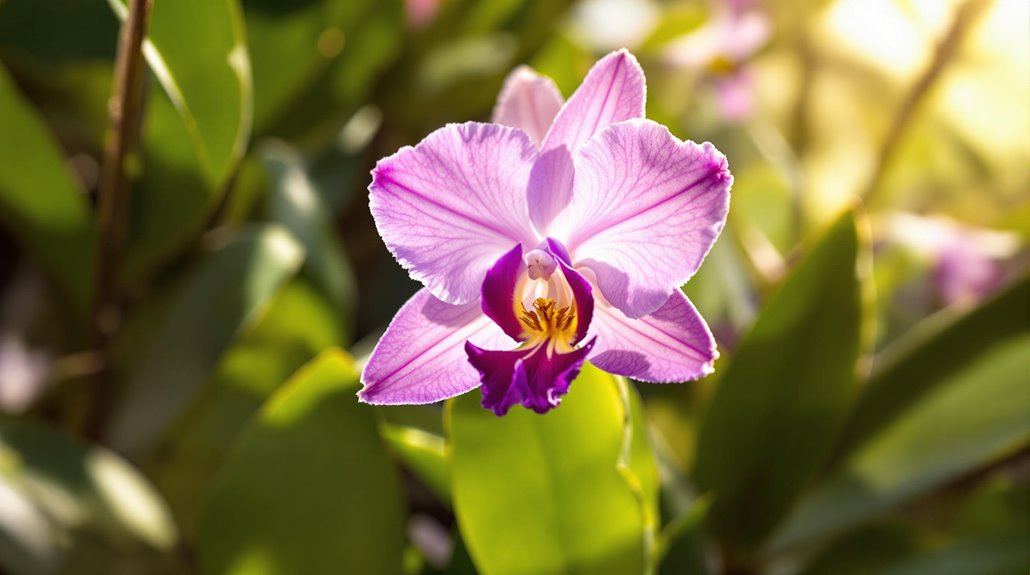
Vanilla's soothing aroma stems from a blend of aromatic compounds like vanillin and p-hydroxybenzaldehyde. When you inhale vanilla, it triggers your olfactory system, activating neurons that relay signals to your brain. This stimulates regions linked to emotion, memory, and relaxation, leading to the release of mood-boosting neurotransmitters. Vanilla's aroma can lower stress hormones, slow your heart rate, and promote a sense of calm. These calming properties make vanilla useful in aromatherapy and other applications. Intrigued to learn more about the fascinating science behind vanilla's universally appealing scent?
The Aromatic Compounds in Vanilla
Vanilla's distinctive aroma arises from a complex blend of aromatic compounds. At the heart of this fragrance are two primary molecules: vanillin and its structural cousin, p-hydroxybenzaldehyde. These compounds, with their unique molecular structure, contribute the warm, sweet, and slightly spicy notes that are so characteristic of vanilla.
Interestingly, the aromatic profile of vanilla is further enhanced by the presence of dozens of other aromatic compounds, each with its own subtle influence. These include acids, alcohols, and esters, all of which work in harmony to create the signature vanilla scent.
The complex interplay of these aromatic molecules is what makes vanilla so soothing and comforting. As you experience the fragrance, your brain is processing a medley of sensory inputs, triggering associations with childhood memories, baked goods, and a sense of warmth and familiarity. This is the science behind vanilla's universally appealing aroma. The vanillin crystals that form on dried vanilla beans are responsible for secreting the sweet, rich aroma that makes vanilla so distinctive.
Vanilla's Interaction With the Olfactory System
When you inhale the alluring scent of vanilla, your olfactory system springs into action. The aromatic compounds in vanilla interact with the olfactory neurons in your nose, triggering a cascade of neural signals that travel to your brain. This process allows you to perceive the aroma of vanilla.
The olfactory neuron function is vital in this mechanism. These specialized neurons have receptors that bind to the volatile compounds in vanilla, generating electrical impulses. These impulses are then transmitted to the olfactory bulb, where the initial processing of the aroma occurs. From there, the signals are relayed to the olfactory cortex, where the perception of the vanilla aroma takes place.
The unique composition of vanilla's aromatic compounds, including vanillin, also plays a role in its soothing effect. These compounds interact with the olfactory system in a way that may promote feelings of calm and comfort, contributing to vanilla's universally appealing aroma. Research has shown that this anxiety-reducing aroma can help alleviate symptoms of claustrophobia and depression through its interaction with the central nervous system.
Physiological Responses to Vanilla's Aroma
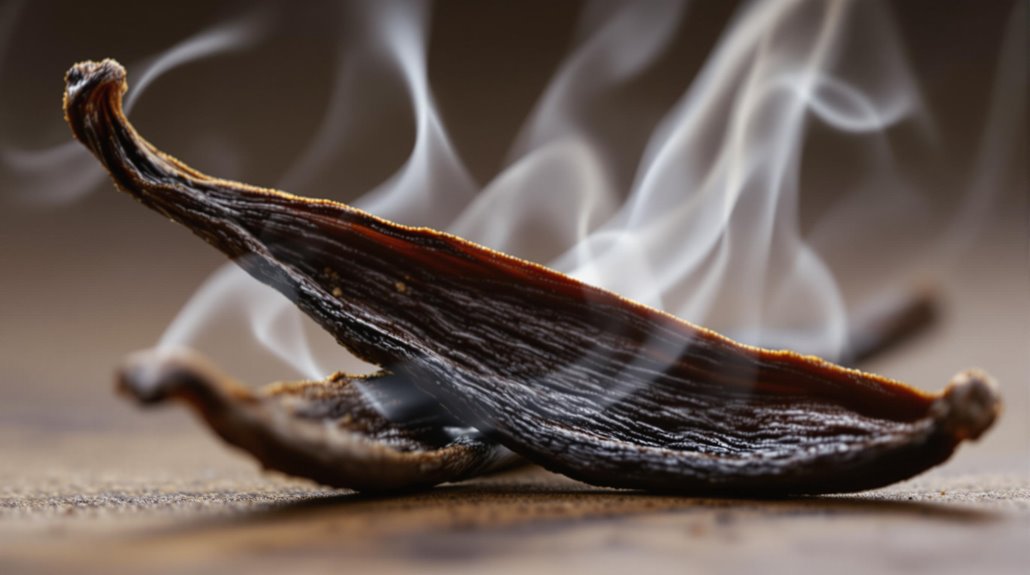
The soothing aroma of vanilla elicits a range of physiological responses in the human body. Through sensory processing mechanisms, the scent of vanilla triggers the release of neurotransmitters like serotonin and dopamine, which play a crucial role in regulating mood, cognition, and emotional well-being.
When you inhale the comforting scent, it stimulates the olfactory receptors in your nasal cavity, sending signals to the olfactory bulb in your brain. This triggers a cascade of neurological events, activating regions associated with emotion, memory, and relaxation. The pleasant fragrance of vanilla has been shown to reduce stress, lower anxiety levels, and promote a sense of calm and contentment.
Furthermore, the aroma of vanilla can positively influence autonomic functions, such as heart rate and blood pressure, leading to a state of physiological relaxation. This soothing effect on the body and mind is why the scent of vanilla is often used in aromatherapy, spa treatments, and various wellness applications. As a natural air freshener, vanilla provides these therapeutic benefits without the harmful effects of volatile organic compounds found in many commercial products.
The Calming Effects of Vanilla
The mood-soothing properties of vanilla's aroma have long been recognized, making it a go-to scent for creating a calming atmosphere. You may have noticed how the warm, comforting fragrance of vanilla can instantly help you relax and unwind. This is because vanilla's therapeutic properties directly influence your brain and body, triggering a series of calming effects on your mood.
Studies show that the compounds in vanilla activate the limbic system, the part of the brain responsible for processing emotions. This activation leads to the release of neurotransmitters like serotonin and dopamine, which can improve your overall sense of well-being and contentment. Additionally, vanilla's aroma has been found to lower cortisol levels, the hormone associated with stress, helping you feel more at ease.
Whether you're diffusing vanilla essential oil or baking with vanilla extract, you can utilize the calming effects of this beloved flavor. Incorporating vanilla into your daily routine can be a simple yet effective way to cultivate a sense of tranquility and relaxation. For a lasting vanilla fragrance in your bedroom, try creating scented drawer liners using concentrated essential oils mixed with water.
Understanding Vanilla's Soothing Properties
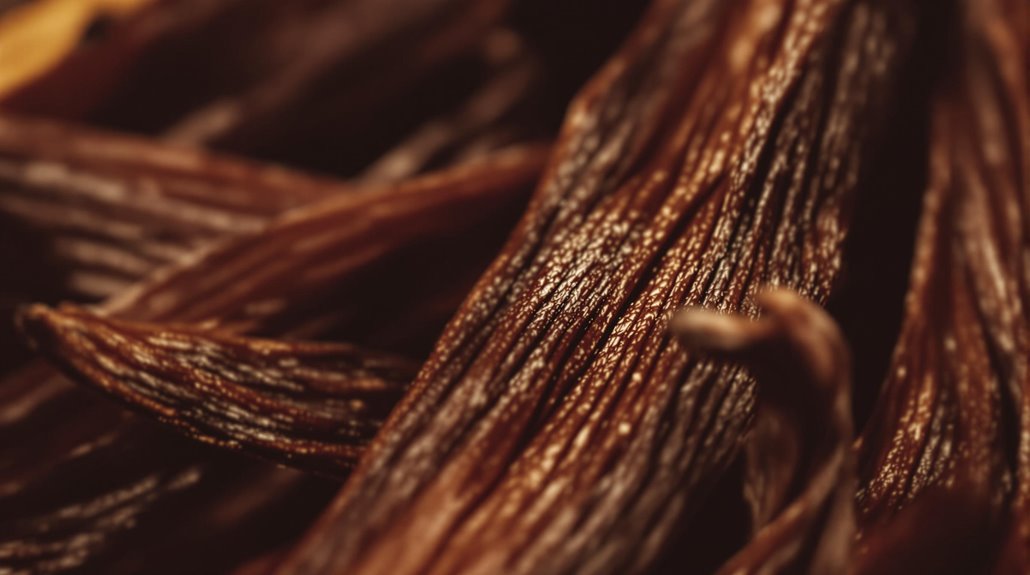
A fundamental reason why vanilla's aroma is so soothing lies in its chemical composition. Vanillin, the primary component responsible for vanilla's distinct fragrance, has been shown to possess calming and relaxing properties. Evolutionarily, this allows vanilla to serve as a natural mood enhancer, signaling to the brain that the environment is safe and secure.
Furthermore, the medicinal uses of vanilla have long been recognized. Extracts from the vanilla plant have been used to alleviate anxiety, insomnia, and even depression. The soothing effects of vanilla are thought to be attributed to its ability to interact with the limbic system, the part of the brain responsible for processing emotions.
When you inhale vanilla's aroma, it triggers a cascade of physiological responses, including reduced heart rate and lower levels of cortisol, the stress hormone. This, in turn, promotes a sense of tranquility and well-being, making vanilla a versatile and effective tool for stress management and relaxation. The calming properties of vanilla also make it an excellent natural bug repellent, providing a pleasant and chemical-free way to deter insects while maintaining a soothing environment.
The Science Behind Vanilla's Relaxing Scent
Diving deeper into the science behind vanilla's relaxing scent, you'll find that the key lies in its primary aroma compound - vanillin. This organic compound stimulates your sensory perception, triggering neurological pathways that elicit a calming response. Studies show vanillin's ability to interact with the limbic system, the part of your brain responsible for processing emotions and memories.
Inhaling vanilla's soothing scent activates the olfactory receptors in your nasal cavity, sending signals to the olfactory bulb. This, in turn, stimulates the amygdala, which plays a pivotal role in regulating your emotional state. The presence of vanillin prompts the release of neurotransmitters like serotonin and dopamine, nurturing feelings of relaxation and well-being.
Furthermore, vanilla's aroma has been linked to reduced stress and anxiety levels. Its calming effects can positively influence your physiological responses, such as lowering heart rate and blood pressure. This makes vanilla a precious tool for promoting overall mental and physical tranquility. When combined with lavender and jasmine, vanilla creates powerful aromatherapeutic blends that enhance its natural calming properties.
The Chemistry of Vanilla's Aroma
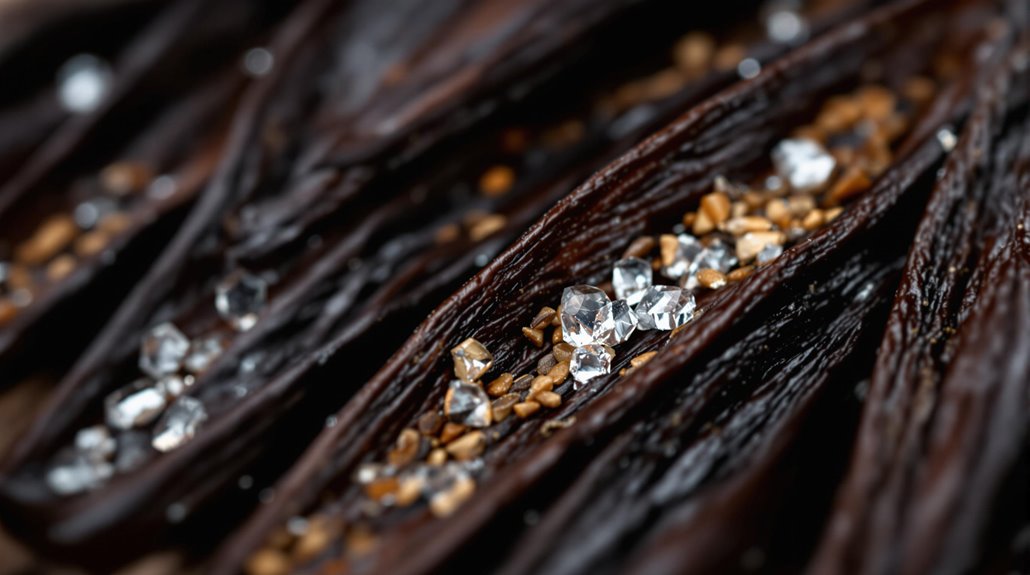
Beyond the soothing effects of vanillin, the chemistry behind vanilla's alluring aroma is truly fascinating. The distinctive fragrance of vanilla is the result of a complex interplay of molecules, each contributing to its unique profile. At the heart of this aroma lies the molecule vanillin, which is responsible for the iconic sweet, creamy notes. But the story doesn't end there. Other compounds, such as eugenol and isoeugenol, add subtle spicy and floral undertones, harmonizing to create the full-bodied scent we associate with vanilla.
The aromatic intensity of vanilla is directly linked to its molecular structure. The presence of aromatic rings and strategic positioning of functional groups allow these molecules to interact with our olfactory receptors, triggering a cascade of neural signals that our brain interprets as the comforting scent of vanilla. This intricate dance of chemistry is what makes vanilla's aroma so mesmerizing and soothing, inviting us to savor its warmth and familiarity. Natural wax types like soy and beeswax provide the most subtle and soothing vanilla scent when used in candle making.
Vanilla's Impact on Stress Levels
The soothing effects of vanilla's aroma go beyond mere pleasure, as numerous studies have demonstrated its ability to markedly reduce stress levels. The mood-enhancing potential of this humble spice lies in its ability to interact with the limbic system, the part of the brain responsible for processing emotions. When you inhale the comforting scent of vanilla, it triggers a cascade of biochemical reactions that calm the mind and body.
Researchers have found that the primary compound in vanilla, vanillin, has a direct impact on stress-related hormones like cortisol. By modulating these hormones, vanilla can help alleviate the physiological symptoms of stress, such as elevated heart rate and blood pressure. This therapeutic application of vanilla's aroma has implications for a wide range of stress-related conditions, from anxiety and depression to chronic pain management.
The science behind vanilla's soothing power is a testament to the remarkable connection between our sense of smell and our overall well-being. Incorporating this natural remedy into your daily life can be a simple yet effective way to heighten your mood and manage stress. Similar to sandalwood's properties, vanilla can be particularly effective when used during meditation and prayer to enhance mental clarity and emotional balance.
Appreciating the Science of Vanilla
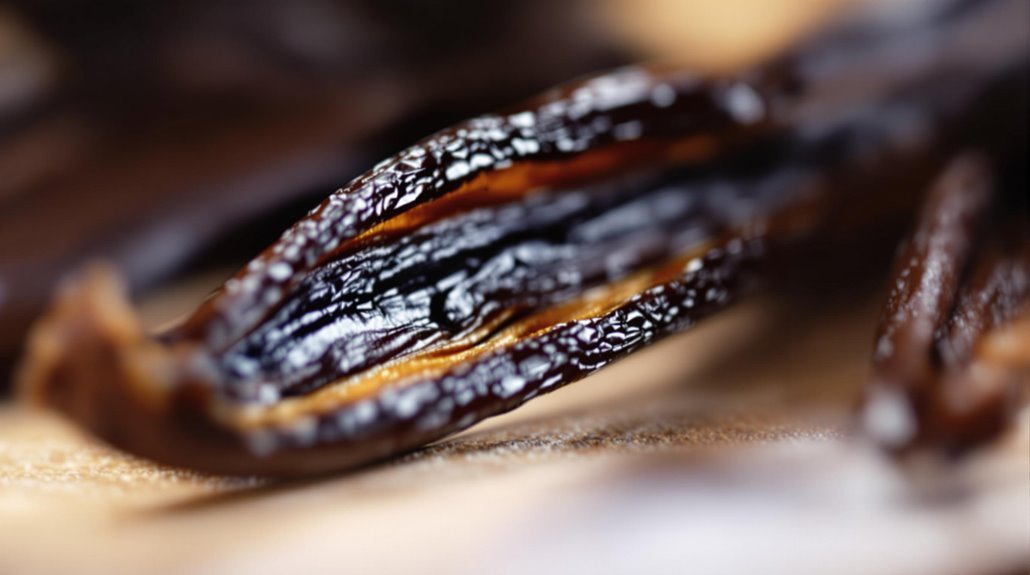
Appreciating the science behind vanilla's alluring aroma provides a deeper understanding of its significant effects on our well-being. The depth of vanilla's culinary versatility is truly exceptional, as its distinctive flavor has been cherished for centuries, dating back to its uncovering by the ancient Mesoamerican civilizations. The historical significance of vanilla is a testament to its enduring appeal, with its use in everything from savory dishes to decadent desserts.
Delving into the science, we uncover that the primary compound responsible for vanilla's aroma is vanillin, which interacts with our olfactory system to evoke a sense of calm and relaxation. This versatile compound has been shown to reduce stress levels, making vanilla a natural ally in promoting overall well-being. By understanding the nuances of vanilla's scientific properties, we can truly appreciate the complexity and profound impact of this captivating botanical marvel. Similar to sandalwood's calming properties, vanilla's soothing aroma can help combat insomnia and improve overall sleep quality.



